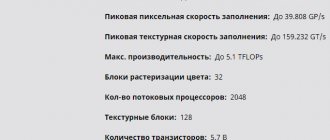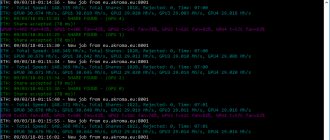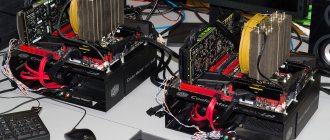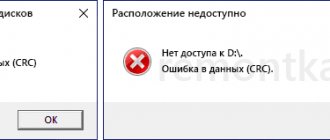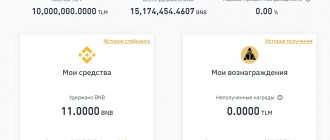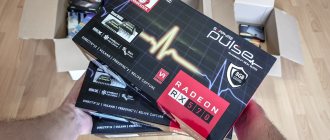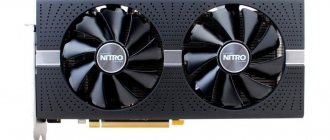The announcement of the Polaris 10 graphics processor allowed AMD to take a confident step forward and its partners to expand their product range. Manufacturers have released many interesting non-standard video cards, differing in cooling systems, overclocking and power subsystem.
Developers from AMD prepared only one version of the reference and it was the Radeon RX 480 8Gb, however, Sapphire was the only one of its kind to release the Sapphire Radeon RX 470 OC model based on it, which is in some way a copy of the familiar reference video card, but with some changes. Despite the apparent similarity, the new product will be of interest to gamers.
PACKING AND EQUIPMENT
The Sapphire Radeon RX 470 OC graphics card comes in a small black and red packaging with a glossy finish and a signature cyborg image. The developers noted the names of the model and manufacturer, the amount of video memory equal to 4 GB of the GDDR5 standard, factory overclocking and supported technologies.
The back of the box contains a description and technical specifications of the model. The new product receives support for the latest functions and is capable of working in tandem with two graphics accelerators in CrossFire mode.
Inside there is a box made of thick cardboard, and the video card is placed in an antistatic bag with air layers that protect the Sapphire Radeon RX 470 OC from various damage during transportation.
In the package, the user can find:
- User guide;
- Disk with drivers and software;
- Product and registration brochures;
- DVI -> HDMI adapter.
APPEARANCE
The Sapphire Radeon RX 470 OC video card received a reference cooling system, but the developers found the strength to significantly improve it. The designers repainted the front panel silver and some other elements. Because of these changes, the Sapphire Radeon RX 470 OC is unofficially called the "Platinum Edition", so don't be surprised if you see this name.
Due to the fact that the new product repeats the reference version, let’s go over the key points.
The Sapphire Radeon RX 470 OC received a reference cooling system, where the central place is given to the radiator, through many fins of which a tangential fan (in common parlance - a turbine) drives air and throws it out through the rear panel. The advantage of this cooler is that heated air is not retained in the case, but the main disadvantage is the noise level. We measured it in our laboratory and made certain conclusions, which we will discuss in the corresponding section.
When looking at the reverse side, a metal plate catches your eye - a backplate that was not there before. It not only acts as an element of rigidity and protects the hinged elements from chipping, but also removes heat from the power subsystem.
COOLING SYSTEM
The cooling system of the Sapphire Radeon RX 470 OC is built according to unshakable canons. An aluminum radiator and a tangential fan with a diameter of 67 mm are hidden under a plastic decorative casing. The entire printed circuit board is covered with a plate, which serves as a cooler for the video memory chips and the VRM area.
On the reverse side, the cooler is attached using a cross, which evenly distributes the load on the small graphics processor. The radiator is a small aluminum block. Unlike the older model RX 480, it does not have a copper core.
Together with the plate covering the printed circuit board and all elements, the backplate is dismantled. It is secured with 12 screws and is involved in cooling the power subsystem. To this end, the developers placed a thick black thermal pad in the VRM area.
PRINTED CIRCUIT BOARD
The Sapphire Radeon RX 470 OC model is built on a reference printed circuit board with all that it implies. Engineers made minor changes to key components.
The AMD Polaris 10 (Ellesmere XT) GPU found on the Radeon RX 480 has been replaced by the Ellesmere PRO (RX 470) version. It includes 2048 shaders, 32 rasterization units and 128 texture units.
The power subsystem has lost two phases; now it is built according to a “4+1” scheme, where four phases are allocated to the graphics processor and one to the video memory.
The new product is equipped with four gigabytes of video memory, assembled by eight chips with a capacity of 128Mx32 MB. They operate at 1650 MHz, but are overclocked to 1750 MHz, and operate at 1.5 Volts.
TESTING
Testing took place on a bench with the following configuration:
- Processor: Intel Core i7-4770K;
- Cooling system: Thermalright Archon;
- Motherboard: MSI Z97 Gaming 5;
- RAM: Kingston HyperX Genesis 8 GB (2X4 GB);
- Hard drive: Transcend 370S 256 GB;
- Power supply: Chieftec APS-1000C 1000W.
The name of the Sapphire Radeon RX 470 OC model speaks for itself: the video card received a slight factory overclock. The core frequency was increased from 926 MHz to 936 MHz, in Boost mode - from 1206 MHz to 1216 MHz at a voltage of 1.0 Volts, video memory now operates at 1750 MHz instead of 1650 MHz.
When idle, the cooling system operates at 760 rpm, the GPU temperature remains at 40-45°C with a very low noise level.
Polaris generation video cards turned out to be very dependent on the “crystal quality” - the ASIC indicator. In our case, it was 80.0%, which allows our sample to work stably at 0.987 V. AIDA64 Extreme Edition indicators:
- DPM0: GPUClock = 300 MHz, VID = 0.80000 V
- DPM1: GPUClock = 466 MHz, VID = 0.81800 V
- DPM2: GPUClock = 751 MHz, VID = 0.82400 V
- DPM3: GPUClock = 1019 MHz, VID = 0.82700 V
- DPM4: GPUClock = 1074 MHz, VID = 0.86200 V
- DPM5: GPUClock = 1126 MHz, VID = 0.90000 V
- DPM6: GPUClock = 1169 MHz, VID = 0.94300 V
- DPM7 : GPUClock = 1216 MHz, VID = 0.98700 V
It is worth noting that in my case, a sample was also purchased and installed in a home PC, where these figures were 70.6% and 1.100 V.
In games and benchmarks it showed the following results. After 10 minutes of operation, the Sapphire Radeon RX 470 OC operated at an average core frequency of 1100 MHz and a voltage of 0.981 V. The GPU warmed up to 80 ° C with a fan speed of 1550 rpm and low noise levels. A characteristic feature of many models is the limitation of video card power consumption at the BIOS level, and for the Sapphire Radeon RX 470 OC model this is 92 W. This does not allow the GPU to operate at the stated 1216 MHz, but keeps the temperature of the VRM zone at 91°C.
Polaris BIOS Editor 1.4 program data:
Max Power Limit (W) = 92 W.
There are two possibilities to increase it - by editing the BIOS or increasing the Power Limit in overclocking utilities. We raised PL by only 20% in MSI AfterBurner and got the following results.
The Sapphire Radeon RX 470 OC video card began to work stably at 1216 MHz. Energy consumption increased slightly - only up to 105 W. The cooler began to operate at 1700 rpm, which had a slight effect on the noise level. The temperature of the GPU and power subsystem was 80°C and 95°C, respectively.
The Sapphire Radeon RX 470 OC video card was overclocked to stable values of 1450 MHz for the core at a voltage of 1.23 V and 2150 MHz for the memory at a fan speed of 2500 rpm.
To visually reflect the gain from overclocking, we used synthetic tests and popular computer games.
The cooling system of the Sapphire Radeon RX 470 OC video card is built according to the reference model, however, the following factors are worth noting. If we compare tangential fans with previous models, for example, the Radeon R9 290X, then its diameter has decreased from 75 to 65 mm, which has a beneficial effect on the acoustic characteristics, and the rotation speed in our case is on average 1600-1700 rpm versus 2800 rpm for the previous generation. All this allows the Sapphire Radeon RX 470 OC model to produce a noise level below average, comfortable for long-term operation.
SUMMARY
Before the results, it’s worth once again going over the main features of the Sapphire Radeon RX 470 OC video card and its differences from the reference:
- — Cutting two phases of power;
- — No BIOS switch;
- — 4 GB of video memory versus 8 GB;
- — Memory frequency 1750 MHz;
- — No copper radiator core.
- + Backplate and VRM zone cooling;
- + Updated silver design;
- + TDP dropped from 150 W to 120 (and even to 92 W according to BIOS);
- + Because of this, the cooling system is quieter.
CONCLUSION
The Sapphire Radeon RX 470 OC video card was a bold move from Sapphire, who were the only ones who decided to release a reference based on Ellesmere PRO, and it bore fruit. The slightly less powerful and stripped-down GPU runs hotter and consumes less, which means the reference model's cooling system can handle heat dissipation better. The developers also took into account the category of buyers, so by abandoning some points they were able to reduce the cost of the new product, making it affordable, and taking into account the above factor - quiet.
These actions made the Sapphire Radeon RX 470 OC video card an attractive model for purchasing and creating a gaming system. The developers were able to not only release a good version of the Radeon RX 470, but also, after performing certain operations, leave a gap with the proprietary Nitro line.
Mining review using Sapphire NITRO + AMD Radeon RX 470 8GB video card
We got our hands on the AMD Radeon RX 470 video card. And not just any, but the best of this series. Namely, the 8GB Sapphire NITRO+ AMD Radeon RX 470. We decided to check how suitable this card is for mining Ethereum (ETH) and other popular cryptocurrencies using various mining algorithms. The RX 470 Sapphire NITRO+ 8GB modification has the best mining performance among all modifications of the RX 470, since it comes with video memory clocked at 2000 MHz (8 Ghz). In other words, this is the same memory frequency as older models, for example, the RX 480.
Video memory speed is especially important for Ethereum mining. However, this video card has other positive aspects, such as an 8-pin PCI-E connector, good cooling and a 1260 MHz GPU clock speed. The only downside is that the price of the Sapphire NITRO+ AMD Radeon RX 470 8 GB is almost the same as the 8 GB RX 480. The 4 GB RX 470 model has slower memory, so Ethereum mining is worse than the 8 GB NITRO+, although other algorithms run not much slower.
The hashing power provided by the Sapphire NITRO+ AMD Radeon RX 470 8GB for Ethereum is approximately 24.5 MHS by default, which is almost the same as the Radeon RX 480. Please note that this Sapphire model uses 8 GHz video memory, while other RX 470 cards use 4 GB comes with 7 GHz or 6.6 GHz video memory, so Ethereum mines slower on them. Sapphire NITRO+ allows you to well overclock the GPU of the card to a maximum of 1260 MHz, although Ethereum does not care about 100% load on the GPU when mining ETH and you can reduce energy consumption without a drop in performance. What I really didn’t like was that the rotation of the fan blades By default it is made very slow to make the card quieter.
While mining Ethereum on the RX 470, we managed to set the fan speed to 1300 rpm, and as a result, the GPU temperature reached 70 degrees Celsius. So manually increasing the temperature seems like a good idea, especially if you're mining coins whose algorithms are more GPU-intensive, as opposed to Ethereum, which is more memory-dependent. Also, the default power consumption for the Sapphire NITRO+ seems a little higher to us than the RX 480.
An attempt to overclock the Sapphire NITRO+ AMD Radeon RX 470 8GB disappointed us a little. We expected to overclock the 8 GHz video memory to at least 8.8 or 9 GHz, like the older model, the RX 480. Unfortunately, we were only able to achieve 8.2 GHz (2050 MHz) using the AMD WattMan tool and a maximum of 8.4 GHz using the ASUS tool GPU Tweak II. We have selected good programs for AMD RX series of GPUs, however, the overclocking limit disappointed us. We're not sure if this is because Samsung's GDDR5 memory chips aren't capable of running at higher frequencies without causing problems, or if it's a safety feature that makes the RX 470, even after overclocking, slower than the RX 480.
The VRAM clock limit only affected Ethereum mining and we were unable to achieve maximum hashing power. With a maximum VRAM speed of 8.4 GHz (2100 MHz), we got about 25.8 MHS of Ethereum mining power, or in other words, about 1.3 MHS more than with the default settings. We still have to see how 4GB RX 470 models with slower memory perform in Ethereum mining, and how well they can be overclocked.
When the AMD Radeon RX 480 was first released, there was a driver issue that prevented users from mining various digital currencies. When I turned on sgminer, the program simply crashed with an error. Since the RX 480 is indeed a new architecture, there is no way to simply revert to the old drivers without having problems running sgminer. It seems that the situation has improved significantly since the product was released, although there are still difficulties with some algorithms and mining programs. Most people have used the RX 480 to mine Ethereum without having any issues with the software to do so. However, for various reasons, many users have switched to mining other digital currencies. Above you can see a table of hashing power figures for many popular Nicehash-enabled algorithms, which have been tested using a variety of different mining software.
You can also see that for the AMD Radeon RX 480 card, when using the NiceHash miner, many algorithms show a hashing power of 0 MHS. At this moment, it is clear that there are still problems with the Neoscrypt, WhirlpoolX and Blake256r14 algorithms, and the program shows a hashing power of 0 MHS. Of course, we only considered the algorithms that NiceHash supports, but there are many others. It is important to note that the Sapphire Nitro+ RX 470 8GB is close to the RX 480 with 8 GB in terms of mining performance. In some cases, thanks to optimizing the settings, even better results are achieved. There are more chips for streaming data processing, which gives the RX 480 an advantage when using some algorithms compared to the RX 470. Unfortunately, the GPU frequency of the RX 470 cannot be increased higher , like the RX 480, since at very high parameters the card will simply stop working.
Let's add information about some more algorithms. LBRY's version of sgminer caused the video driver to crash, so we were unable to obtain hashing power results. As for running sgminer for SiaCoin, we ended up seeing 906 MHS hashing power on the Siamining pool using the Stratum protocol, so we had no issues with that program. We hope that the problems with some mining programs and algorithms that do not run on the new AMD RX series graphics cards will be resolved. AMD is already preparing to release a new graphics card, the RX 490, and it looks like it will also be of interest to cryptocurrency miners.
Want more news? Facebook. Fastest? Telegram and Twitter. Subscribe!
Read all about mining: Mining Bitcoin and other cryptocurrencies Review of Ethereum mining using an AMD Radeon RX 480 video card How to configure the Radeon RX 480 BIOS to speed up Ethereum mining
#ethereum #Radeon RX 470 #Sapphire NITRO #mining #etherium
- Anton
: I don’t understand why the fans should be overclocked on purpose? Why raise the temperature? - Stas_Miner
Why not flash the timings? My Rx470 Nitro+ 4GB 7000mhz gives ETH+DCR 120+2400... Timings from 1750, 1169 core, 2160 memory... 142 hours without interruption


